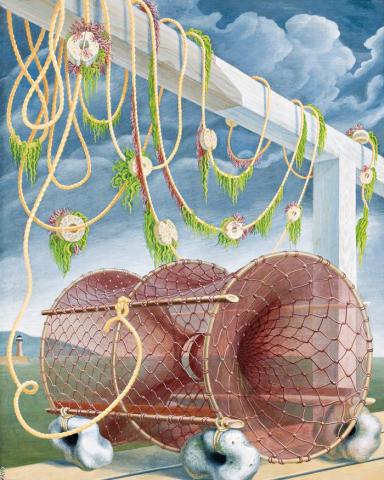LOBSTER POT, EARLY 1940S
Eileen Mayo
tempera on board
40.5 x 32.5 cm
signed lower left: MAYO
original label verso with artist's name, address and title
Whitford Fine Art, London
Private collection, Melbourne
The Surrealist seascape Lobster Pot is one of the finest paintings by Eileen Mayo to come onto the market in recent years. A quiet celebrity of the international art world, for a time she was one of the most overlooked talents of British-Australasian art. Widely acclaimed in London from the twenties until she moved to Australia in 1952, Mayo's contacts ranged from Serge Diaghilev and Sir Julian Huxley to Jean Lurçat and Edward Wadsworth, her designs being described by Kenneth Clark as 'outstandingly good.'1 Mayo studied first at the Slade School, then lithography, calligraphy and wood engraving in the evening classes of the Central School of Arts and Crafts. Instructed in linocutting by Claude Flight, whom she met when modelling at the Grosvenor School of Modern Art to supplement her income, he invited her to participate in The Second Exhibition of British Linocuts at the Redfern Gallery. Her annual entries from 1930 to 1934 were acquired by the Victoria and Albert Museum.2 A considerable beauty, she initially supported herself through commercial work and modelling for some of the leading British artists of the day, especially Laura Knight, Vanessa Bell, Bernard Meninsky and Duncan Grant. It was through Knight that she received her first major commission, which started her very successful career as an illustrator. She wrote and illustrated numerous books, and contributed to Art & News Review, founded by her husband Richard Gainsborough. In 1951, her tapestry Echinoderms, along with Graham Sutherland's Wading Birds were among three contemporary works selected for the exhibition English Tapestries shown during the Festival of Britain. After moving to Australia, then onto New Zealand 1962, she continued to achieve acclaim for her designs for Australian and New Zealand postage stamps and posters for the Australian National Travel Association, gaining international recognition and awards for both. In 1994, she was awarded a DBE for her lifetime dedication to art.
Mayo was one of a very few British artists using egg tempera at this time, the medium being ideally suited to her temperament and technical brilliance. Significantly, Edward Wadsworth was another, Mayo being in frequent contact with him during the Second World War. She was also influenced by his Surrealist paintings of marine still life, as seen in Lobster Pot. Striking in its clarity, immaculate surface and sense of design, a decided Surrealist note is introduced through compositional devices of the low horizon and imaginative inversion of scale between foreground and background images. Mayo's characteristic attention to the smallest detail adds to the feeling of the super-real, with all enveloped in an atmosphere of ethereal stillness.
1. Quoted in Cassidy, J., 'Eileen Mayo: Her Prints, Posters, and Postage Stamps', Woman's Art Journal, New Brunswick, vol. 24, no.1, Spring "Summer, 2003, p. 21
2. ibid., p. 18
DAVID THOMAS
